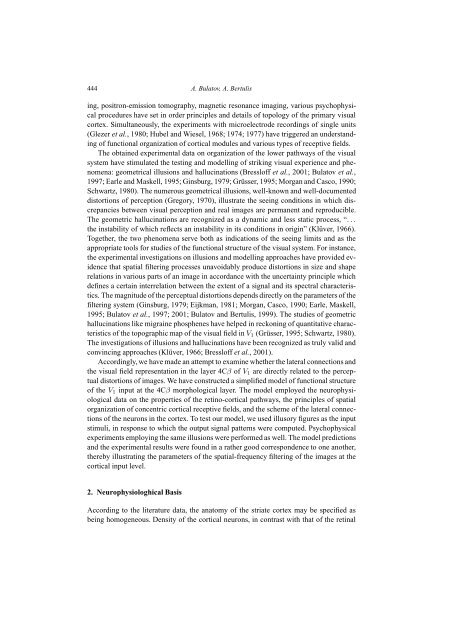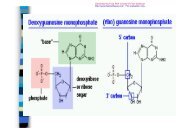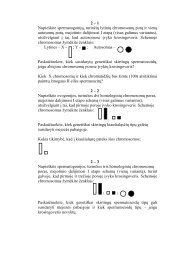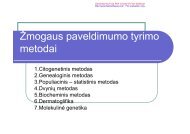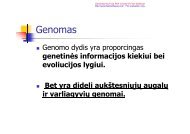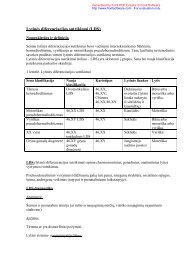stimuli
Visual Image Filtering at the Level of Cortical Input
Visual Image Filtering at the Level of Cortical Input
- No tags were found...
Create successful ePaper yourself
Turn your PDF publications into a flip-book with our unique Google optimized e-Paper software.
444 A. Bulatov, A. Bertulis<br />
ing, positron-emission tomography, magnetic resonance imaging, various psychophysical<br />
procedures have set in order principles and details of topology of the primary visual<br />
cortex. Simultaneously, the experiments with microelectrode recordings of single units<br />
(Glezer et al., 1980; Hubel and Wiesel, 1968; 1974; 1977) have triggered an understanding<br />
of functional organization of cortical modules and various types of receptive fields.<br />
The obtained experimental data on organization of the lower pathways of the visual<br />
system have stimulated the testing and modelling of striking visual experience and phenomena:<br />
geometrical illusions and hallucinations (Bressloff et al., 2001; Bulatov et al.,<br />
1997; Earle and Maskell, 1995; Ginsburg, 1979; Grüsser, 1995; Morgan and Casco, 1990;<br />
Schwartz, 1980). The numerous geometrical illusions, well-known and well-documented<br />
distortions of perception (Gregory, 1970), illustrate the seeing conditions in which discrepancies<br />
between visual perception and real images are permanent and reproducible.<br />
The geometric hallucinations are recognized as a dynamic and less static process, “...<br />
the instability of which reflects an instability in its conditions in origin” (Klüver, 1966).<br />
Together, the two phenomena serve both as indications of the seeing limits and as the<br />
appropriate tools for studies of the functional structure of the visual system. For instance,<br />
the experimental investigations on illusions and modelling approaches have provided evidence<br />
that spatial filtering processes unavoidably produce distortions in size and shape<br />
relations in various parts of an image in accordance with the uncertainty principle which<br />
defines a certain interrelation between the extent of a signal and its spectral characteristics.<br />
The magnitude of the perceptual distortions depends directly on the parameters of the<br />
filtering system (Ginsburg, 1979; Eijkman, 1981; Morgan, Casco, 1990; Earle, Maskell,<br />
1995; Bulatov et al., 1997; 2001; Bulatov and Bertulis, 1999). The studies of geometric<br />
hallucinations like migraine phosphenes have helped in reckoning of quantitative characteristics<br />
of the topographic map of the visual field in V 1 (Grüsser, 1995; Schwartz, 1980).<br />
The investigations of illusions and hallucinations have been recognized as truly valid and<br />
convincing approaches (Klüver, 1966; Bressloff et al., 2001).<br />
Accordingly, we have made an attempt to examine whether the lateral connections and<br />
the visual field representation in the layer 4Cβ of V 1 are directly related to the perceptual<br />
distortions of images. We have constructed a simplified model of functional structure<br />
of the V 1 input at the 4Cβ morphological layer. The model employed the neurophysiological<br />
data on the properties of the retino-cortical pathways, the principles of spatial<br />
organization of concentric cortical receptive fields, and the scheme of the lateral connections<br />
of the neurons in the cortex. To test our model, we used illusory figures as the input<br />
<strong>stimuli</strong>, in response to which the output signal patterns were computed. Psychophysical<br />
experiments employing the same illusions were performed as well. The model predictions<br />
and the experimental results were found in a rather good correspondence to one another,<br />
thereby illustrating the parameters of the spatial-frequency filtering of the images at the<br />
cortical input level.<br />
2. Neurophysiologhical Basis<br />
According to the literature data, the anatomy of the striate cortex may be specified as<br />
being homogeneous. Density of the cortical neurons, in contrast with that of the retinal


